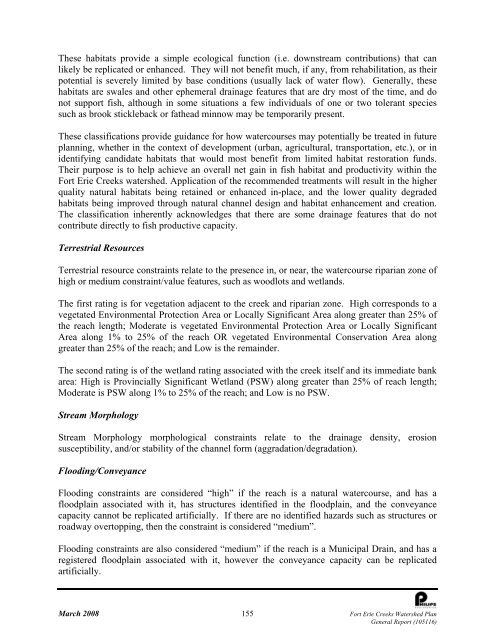Fort Erie Creeks Watershed Plan - Niagara Peninsula Conservation ...
Fort Erie Creeks Watershed Plan - Niagara Peninsula Conservation ...
Fort Erie Creeks Watershed Plan - Niagara Peninsula Conservation ...
You also want an ePaper? Increase the reach of your titles
YUMPU automatically turns print PDFs into web optimized ePapers that Google loves.
These habitats provide a simple ecological function (i.e. downstream contributions) that can<br />
likely be replicated or enhanced. They will not benefit much, if any, from rehabilitation, as their<br />
potential is severely limited by base conditions (usually lack of water flow). Generally, these<br />
habitats are swales and other ephemeral drainage features that are dry most of the time, and do<br />
not support fish, although in some situations a few individuals of one or two tolerant species<br />
such as brook stickleback or fathead minnow may be temporarily present.<br />
These classifications provide guidance for how watercourses may potentially be treated in future<br />
planning, whether in the context of development (urban, agricultural, transportation, etc.), or in<br />
identifying candidate habitats that would most benefit from limited habitat restoration funds.<br />
Their purpose is to help achieve an overall net gain in fish habitat and productivity within the<br />
<strong>Fort</strong> <strong>Erie</strong> <strong>Creeks</strong> watershed. Application of the recommended treatments will result in the higher<br />
quality natural habitats being retained or enhanced in-place, and the lower quality degraded<br />
habitats being improved through natural channel design and habitat enhancement and creation.<br />
The classification inherently acknowledges that there are some drainage features that do not<br />
contribute directly to fish productive capacity.<br />
Terrestrial Resources<br />
Terrestrial resource constraints relate to the presence in, or near, the watercourse riparian zone of<br />
high or medium constraint/value features, such as woodlots and wetlands.<br />
The first rating is for vegetation adjacent to the creek and riparian zone. High corresponds to a<br />
vegetated Environmental Protection Area or Locally Significant Area along greater than 25% of<br />
the reach length; Moderate is vegetated Environmental Protection Area or Locally Significant<br />
Area along 1% to 25% of the reach OR vegetated Environmental <strong>Conservation</strong> Area along<br />
greater than 25% of the reach; and Low is the remainder.<br />
The second rating is of the wetland rating associated with the creek itself and its immediate bank<br />
area: High is Provincially Significant Wetland (PSW) along greater than 25% of reach length;<br />
Moderate is PSW along 1% to 25% of the reach; and Low is no PSW.<br />
Stream Morphology<br />
Stream Morphology morphological constraints relate to the drainage density, erosion<br />
susceptibility, and/or stability of the channel form (aggradation/degradation).<br />
Flooding/Conveyance<br />
Flooding constraints are considered “high” if the reach is a natural watercourse, and has a<br />
floodplain associated with it, has structures identified in the floodplain, and the conveyance<br />
capacity cannot be replicated artificially. If there are no identified hazards such as structures or<br />
roadway overtopping, then the constraint is considered “medium”.<br />
Flooding constraints are also considered “medium” if the reach is a Municipal Drain, and has a<br />
registered floodplain associated with it, however the conveyance capacity can be replicated<br />
artificially.<br />
March 2008 155 <strong>Fort</strong> <strong>Erie</strong> <strong>Creeks</strong> <strong>Watershed</strong> <strong>Plan</strong><br />
General Report (105116)
















